Vanda Felbab-Brown testifies before the Subcommittee on Terrorism, Nonproliferation, & Trade of the House Foreign Affairs Committee on Afghanistan’s terrorism resurgence, concluding that improving Afghan governance, not merely beefing up military efforts and countering external sponsors of terrorism in Afghanistan, is critical.
Chairman Poe, Ranking Member Keating, and Members of the Subcommittee:
I am honored to have this opportunity to address the Subcommittee on the problem of the resurgence of terrorism in Afghanistan.
The threats posed by terrorism as well as the issues of the country’s security, stabilization, and state-building efforts are the domain of my work on Afghanistan, and the subject of my book, Aspiration and Ambivalence: Strategies and Realities of Counterinsurgency and State Building in Afghanistan (Brookings, 2013) as well as numerous reports — most recently “Afghanistan Affectations: How to Break Political-Criminal Alliances during Transitions from War to Peace.” I repeatedly conduct fieldwork in Afghanistan on these issues.
In my testimony, I first discuss U.S. interests in Afghanistan. I then analyze the state of Afghanistan today, including the influence of the Taliban and the growth of the Islamic State and the state of the military battlefield and politics in Afghanistan. Third, I examine the sources of militancy and terrorism in Afghanistan, including the role of external sponsors such as Pakistan and crucially, the role of poor governance and extensive predatory criminality and corruption in Afghanistan, and the measures that the Afghan National Unity Government (NUG) of President Ashraf Ghani and CEO Abdullah Abdullah have undertaken to tackle critical challenges. Finally, I end with a set of recommendations.
I conclude that improving governance, not merely beefing up military efforts and countering external sponsors of terrorism in Afghanistan, is critical.
I. U.S. Counterterrorism and Other Interests in Afghanistan
The principal objective of U.S. policy in Afghanistan since the 9-11 attacks has been –and appropriately continues to be — to ensure that the country does not become a haven for virulent salafi (radical anti-Western jihadi) terrorist groups like al Qaeda. The premise underlying this policy subsequent to the toppling of the Taliban regime in 2001 is that if any part of the liberated territory once again comes under the control of salafi groups or a Taliban sympathetic to such groups, their capacity to increase the lethality and frequency of their terrorist attacks — including against U.S. assets—will increase since they will be able to use the safe-havens to plan and train for their operations and more easily escape retaliation by the United States and the international community.
Yet there is significant policy and scholarly debate as to how closely aligned the Taliban is today with the terrorist groups and whether the Taliban would once again allow al Qaeda to operate out of a territory it controls. Indeed, some members of the Taliban considered acquiescence to al Qaeda operations a key strategic mistake and call for distancing the group from al Qaeda. The Taliban also actively battles the Islamic State in Afghanistan. At the same time, the Taliban has not denounced al Qaeda officially, undoubtedly because it knows that openly breaking with al Qaeda would cost the Taliban political capital with jihadi groups around the globe and their financial backers, such as in the Middle East.
While al Qaeda has been severely degraded, it has lost none of its zeal to strike Western countries and undermine governments in Asia, the Middle East, and Africa. The group continues to look for opportunities to exploit and territories to colonize, even if only vicariously through proxies, such as in Western and Eastern Africa, even if some of its local alliances are only fleeting and unreliable. In Afghanistan, the terrorist group has also experienced a resurgence in territories where the presence of the Afghan government and international military forces is limited and weak.
The Islamic State in Afghanistan, a newer terrorist group in name, consisting of various Taliban splinter elements and other relabeled militant groups, is also a prime U.S. target.
However, U.S. interests in Afghanistan go beyond terrorism. An unstable Afghanistan risks also destabilizing Pakistan, and as a result, the entire region of Central and South Asia. Pakistan’s tribal areas as well as Baluchistan and other areas deep in Pakistan, including Karachi, for example, have been host to many of the salafi groups, and the Afghan Taliban and its vicious Haqqani branch use these areas as safe-havens. Thus Pakistan’s cooperation is crucial for effectively countering terrorism in Afghanistan, even if as yet largely not forthcoming. But the reverse is also true: If Afghanistan is unstable and contains salafi groups that leak over into Pakistan, Pakistan itself becomes deeply destabilized and distracted from tackling its other crises, including militancy in the Punjab and a host of domestic calamities, such as intense political contestation, a distorted economy, widespread poverty, and a severe energy crisis.
A disintegration of the Afghan state or an outbreak of a full-blown civil war will be a great boost to salafi groups throughout the world: once again, a great power will be seen as having been defeated by the salafists in Afghanistan. From a strategic perceptions standpoint, few areas are as important as Afghanistan. The view that the United States has been defeated does not require that the Taliban retake over the country. From the salafi perspective, merely a gradual, but steady crumbling of the Kabul government, with a progressively greater accretion of territory and power by the Taliban, would be sufficient to claim victory.
Finally, the U.S. reputation and self-regard—as a country that can be relied upon to honor its commitments – are at stake in Afghanistan. In mobilizing support for Operation Enduring Freedom, the mission to topple the Taliban regime in the wake of 9-11, the United States made a pledge to the Afghan people to help them improve their difficult condition and not abandon them once again. Although often caricatured as anti-Western, anti-government, anti-modern, and stuck in medieval times, Afghans crave what others do – relief from violence and insecurity and sufficient economic progress to escape dire, grinding poverty. But on its own, the altruistic concern for the people of Afghanistan is not sufficient for the U.S. to undertake — or to perpetuate — what has turned out to be an immensely costly effort. Nor should the tyranny of sunk costs determine U.S. policy in Afghanistan. To paraphrase U.S. strategist George Kennan’s counsel to the Senate Committee on Foreign Relations about the U.S. war in Vietnam, the hallmark of a great power is to know when to liquidate unwise commitments. However, U.S. engagement in Afghanistan, including our deployment of adequate military force, still advances key U.S. interests and provides a crucial lifeline for the Afghan government and the country’s pluralistic post 9-11 political dispensation. Moreover, once the United States made its initial decision to intervene, consideration for the elemental needs of the Afghan people — whose lives we have altered so profoundly — must matter.
Thus, not just counterterrorism objectives but other U.S. interests and values still call for a judicious continuation of U.S. military, political, diplomatic, and economic efforts in Afghanistan.
II. The State of Afghanistan Today
However, Afghanistan remains in a highly precarious condition. After more than a decade of U.S. and international efforts to stabilize Afghanistan and build up the country’s governance structures, the U.N. special envoy in Afghanistan Nicholas Haysom stated in March 2016 when briefing the U.N. Security Council that if Afghanistan merely survived 2016 the United Nations mission in the country would consider it a success.1 Afghanistan did survive 2016 without much of the country falling into the hands of the Taliban, or the government collapsing with a protracted political crisis ensuing, and without a full-blown civil war breaking out. But 2016 also accomplished little in reversing the multiple deleterious trends that motivated the special envoy’s comments. Security continued to worsen palpably.
During the two and a half years since the United States and NATO turned the fighting over to the Afghan National Security Forces (ANSF), the Taliban has mounted and sustained its toughest military campaign yet, and the war has become bloodier than ever. Despite the Taliban’s internal difficulties, its military energy shows no signs of fizzling out. It has been scoring important tactical and even strategic victories. Insecurity has increased significantly throughout the country, civilian deaths have shot up, and the Afghan security forces are taking large, and potentially unsustainable, casualties as other ANSF deficiencies, including corruption that affects both unit performance and sustainment capacity, persist. Significant portions of Afghanistan’s territory, including the provincial capital of Kunduz and multiple districts of Helmand, have fallen (at least temporarily) to the Taliban over the past two years. Moreover, the Islamic State (IS) established itself in Afghanistan in 2015, although it faces multiple and strong countervailing forces.
Although borrowing its name from the Islamic State in the Middle East and proclaiming allegiance to it, the Islamic State in Afghanistan is not a Middle East export to the country. Rather, it consists of several splinter groups and elements expelled from the Taliban, including some too brutal and too sectarian even for the mainstream Taliban. Eastern Nangarhar in particular has emerged as the strongest base of IS presence in Afghanistan. In other parts of the country, such as the north, foreign elements, including Uzbek and Pakistani militants, including factions of Lashkar-e-Taiba and Tehrik-e-Taliban-Pakistan, relabeled themselves IS.
An IS growth in Afghanistan faces substantial obstacles: The group’s brutality, greater than even the brutality Afghans have been subjected to for decades, generates resentment. The Taliban has been better able to calibrate brutality and hide or excuse the violence it perpetrates against civilians. At times, the Taliban has even temporarily reduced violence and overly-restrictive edits to generate acceptance by local populations. By contrast, like IS in the Middle East, IS in Afghanistan has chosen to rule by sheer brutality. The Taliban has also sponsored opium poppy cultivation in Afghanistan and the jobs and income it provides for ordinary Afghans, thus generating political capital. IS in Afghanistan, on the other hand, has prohibited opium poppy cultivation both on grounds of ideological purity the strategic goal of ensuring that the only employment available to local men is as IS foot soldiers.
IS in Afghanistan has also drawn the attention of international actors, and the Taliban has been able to capitalize on being seen as a lesser threat by outside powers. For Russia and Iran, the Islamic State is an even greater threat than the Taliban. Both countries have provided support to the Taliban in order to fight IS but also as part of their anti-American efforts.
Far more ominous, however, than the emergence of the Afghan version of IS for the stability of Afghanistan and the long-term success of counterterrorism efforts in the country is how fractious and polarized politics in Afghanistan remain. The National Unity Government (created in the wake of the highly contested presidential elections of 2014) has not yet really found its feet. The weakness of the NUG, its political dependencies and entanglements, and its other priorities, have also limited and undermined its willingness and ability to robustly tackle the predatory criminality, illicit economies, and organized crime that have become so intermeshed with Afghanistan’s political system and international counterinsurgency operations. The country’s illicit economies such as illegal mining and logging and drug trafficking have financed and stimulated some aspects of the post-2001 violent conflict. But it is particularly the predatory criminality — involving usurpation of land, taxes, and customs, generalized extortion, thuggish monopolistic domination of international contracts and local economic markets, and usurpation of international aid – that has even more severely undermined the stabilization and reconstruction efforts. Combined with the capricious and rapacious rule by Afghan powerbrokers, the predatory criminality allows the Taliban, despite its brutality, to to present itself as a more predictable and less corrupt ruler and gives the insurgency critical traction and resilience.
III. The Sources of Militancy and Terrorism in Afghanistan
The persistence of militancy in Afghanistan and the resilience of terrorist groups operating there are the product of external sponsorship as well as weak, corrupt, and inadequate governance in Afghanistan.
The Geopolitics of Afghan Insurgency: Taliban’s Sanctuaries in Pakistan
The Taliban developed its military capabilities by taking advantage of sanctuaries in Pakistan’s Federally Administered Tribal Areas and the Khyber-Pakhtunkhwa and Baluchistan provinces, and over time even in places far from border areas, such as Karachi. Although nominally a strategic ally of the United States, Pakistan provided the Taliban and its affiliate branches, such as the vicious Haqqani group responsible for the most atrocious terrorist attacks in Afghanistan, including Kabul, with not only safe-havens after 2001, but also direct military and intelligence support. Although receiving very large U.S. counterterrorism assistance in the form of financial aid and military equipment and facing intense U.S. pressure for almost two decades, Pakistan has not severed its support for the Taliban.
A dominant lens though which Pakistan’s military-intelligence establishment continues to see Afghanistan is Pakistan’s long-standing rivalry with India. More than a decade after 9-11, Pakistan’s military-intelligence establishment remains preoccupied with India’s ascendance at a time of Pakistan’s own stagnation and atrophy. Afghanistan has repeatedly been a prime theater for Indian and Pakistani rivalries. Fearing encirclement by India, Pakistan has been greatly reluctant to suppress Afghan militant groups using Pakistan for sanctuary – such as the Afghan Taliban and Haqqani networks and their insurgent and criminal activities, including many forms of smuggling. Pakistan’s continuing support for these groups, despite pressure from the United States and NATO, reflects the persistent view of the Pakistani military-intelligence establishment that the jihadi groups are critical assets in preventing threats on Pakistan’s western flank from an India-friendly regime in Kabul and in securing access to Central Asia’s trade routes.
However, Pakistan’s unwillingness to cease its support for the Taliban also reflects its uncertainties and internal limitations. Pakistan does not have anything approaching total control over the various militant groups that operate from its territory, including the Afghan Taliban. Nor does it have adequate control of the border areas. At the same time, it cannot any longer unequivocally see the Afghan Taliban as an easily-controllable and straight-forward asset. Should the Taliban come to power in Afghanistan or just parts of the country’s territory, would it be willing to renege on its debts and friendships with other fellow jihadists, deny bases of operation to anti-Pakistan militant groups, and do Rawalpindi’s bidding? Pakistan cannot count on such outcomes. Its policies toward the militants, including its unwillingness for years to launch a military operation into North Warizistan to dislodge the Afghan Taliban there, despite years of intense U.S. pressure, are determined as much by incompetence, inertia, and a lack of capacity, as by calibrated duplicitous misdirection. And when the Pakistan military finally went into North Waziristan in 2014, it allowed the Afghan Taliban and the Haqqanis to escape into Afghanistan, blaming the U.S. and Afghanistan for their inability to secure the border and capture the fleeing insurgents. Indeed, some anti-Pakistani militants also escaped into eastern Afghanistan where the writ of the Afghan state is particularly weak, establishing sanctuaries there.
Finally, Pakistan’s willingness to accommodate anti-Afghanistan militant groups is also motivated by fear of provoking them to start violence in Punjab and threaten the core of the Pakistani state, instead of focusing externally.
Weak and Poor Governance and Corruption in Afghanistan
But the Taliban’s strength, resilience, and increasing military and political influence are not merely a matter of continued support from Pakistan, nor of the appeal of the Taliban’s ideology or anti-Western sentiments or Pashtun mobilization in Afghanistan. In fact, much of the Taliban resilience and growing capacity comes from outperforming the government and government-aligned powerbrokers on the ground in delivery of governance and in the suppression of predatory crime. While Taliban governance is brutal and inadequate and not something most Afghans wish for, they often still find it more tolerable than the misgovernance, power abuse, capriciousness, corruption, and paralysis they face from the state and state-aligned authorities.
A factor that critically allows the Taliban to gain traction with Afghans has been the failure of the post-Taliban regime in Kabul to build up state capacity or deliver good governance and act against predatory criminality. The new state under former President Hamid Karzai (2001-2014) failed not only to meet the expectations of the population for economic development and service delivery but also to maintain elemental security. Karzai sought to govern by cooption and payoffs, such as appointments, to the country’s powerbrokers. The current President Ashraf Ghani sought to bring efficiency and technocratic skills to governance, but in doing so reduced the numbers and layers of those having a stake in reform to a much narrower clique of supporters.
Furthermore, the persistent inability to establish good governance, even in areas repeatedly cleared by ISAF and ANSF forces, has often made any security gains highly ephemeral. The state’s presence, though meager, often continues to be viewed as basically malign by many Afghans. And it has in fact been characterized by rapaciousness, nepotism, corruption, tribal discrimination, and predatory behavior from government officials and powerbrokers closely aligned with the state. Patronage has been a key determining factor in whether one gets access to resources.
Crime—such as land theft by rival tribes and land grabbing by corrupt power brokers, nepotistic and unfulfilled contracts, and embezzlement—has spread throughout the country. Officers of the Afghan National Police (ANP) have themselves frequently perpetrated various crimes. The police as well as the judicial system are seen by Afghans as among the most corrupt institutions.
The dearth of a multifaceted state presence, including effective law enforcement and formal judicial processes, has exacerbated the pervasive lack of rule of law. Many communities have been left without reliable mechanisms for dispute resolution and the dispensation of justice. At the same time, conflicts over land and water and tribal feuds have escalated due to the absence of the Taliban mailed fist, the lack or venality of formal courts, and a weakening of informal (tribal) dispute resolution codes. Old warlords, now frequently officials at all levels of the Afghan government, have often usurped power for personal enrichment. They regard their positions as governors, police chiefs, and members of provincial development councils (the key governing body at the provincial level), once again, as personal fiefs. During Karzai’s presidency, corruption became rampant and deeply embedded. And the corruption has s intensified, partially fueled by the bourgeoning illegal poppy cultivation, but also by the structural deficiencies of state institutions, the predatory behavior of official and unofficial power brokers, and the influx of vast, often unmonitored, sums of foreign aid.
In this environment of uncertainty, pessimism, and unpredictable or absent rule of law, the Taliban has employed several mobilization strategies and messages. It has stepped into the lacuna of good governance by disbursing its own “justice” and order—however harsh and arbitrary—adjudicating disputes, such as over land and water, and acting against crime. For mediating tribal, criminal, and personal disputes, the Taliban does not charge money. Afghans report a great degree of satisfaction with Taliban verdicts, unlike those from the official justice system where they frequently have to pay unaffordable and unreliable bribes. The Taliban also has put a great effort into building a shadow government system that includes its own provincial and district governors and civilian commissions.
No doubt, intimidation by the Taliban and a calculation of who will prevail on the battlefield in any given area also fundamentally determine with whom the population aligns or whether it sits on the fence. If the Afghan government and NATO forces are unable to protect a community from retaliation by the Taliban, and the Taliban specifically targets those seen as cooperating, or even merely interacting with, the Afghan government or ISAF, few will be motivated to risk resistance. Instead, they will passively acquiesce to the Taliban’s presence and even to its rule.
The establishment of the National Unity Government emerging from the highly contested and fraudulent 2014 presidential election in Afghanistan provided a unique opportunity to meaningfully improve governance and tackle the criminality and corruption that delegitimized the post-2001 political dispensation. Improving governance and reducing corruption was the one policy on which Ashraf Ghani and Abdullah Abdullah agreed and on which both of them had campaigned.
Instead, although the NUG raised expectations of justice and for an accountable government delivering services and, crucially, combatting corruption and power abuse, it has failed thus far to deliver robustly on any of these promises. One reason is that Ghani and Abdullah were of course deeply beholden to corrupt elites without whose support they would not have been able to run in the elections, and on whose support they continued to depend after the elections. Thus, two and a half years after the formation of the NUG not even one notorious powerbroker has been prosecuted or even dismissed and marginalized. Moreover, immediately after its creation, the NUG was paralyzed by infighting between the two leaders and their factions.
Ghani’s unwillingness and inability to move against powerbrokers deeply implicated in criminality and corruption was also driven by his decision early in his administration to prioritize outreach to Pakistan, and through Pakistan to negotiate a peace with the Taliban. Like Karzai, Ghani came to see Pakistan as the magic key to the negotiated deal, and, like Karzai, he became bitterly disappointed by and frustrated with Pakistan in his first two and a half years, with negotiations getting no traction and terrorism and militancy only escalating in Afghanistan and sapping Ghani’s political capital.
Thus the anti-crime and anti-corruption measures that Ghani and the NUG did undertake have hardly been robust and momentous enough. Ghani’s reopening of the notorious case of the fraudulent Kabul bank did not increase asset recovery and Ghani even sought to make an economic deal with the chief perpetrator of the Kabul bank fraud. With determined international assistance and under international pressure, Ghani’s decision to suspend and clean up a $1 billion fuel contract for the Afghan Ministry of Defense was more successful.
However, this important case has not yet translated into a broader clean-up of the massive corruption that still pervades the Afghan security forces, nor has it generated any meaningful follow-up with policies to systematically deter corruption. The tangle of ethnic divisions and rifts and competing patronage networks that for years have run through the Afghan security forces complicate systematic anti-corruption efforts. Challenged on the battlefield and suffering large casualties and retention problems, Afghan security forces are themselves critically weakened and undermined by pervasive corruption and ethnic and patronage rifts. The fall of Kunduz City in October 2016 and the struggle the ANSF have been experiencing in Helmand province for the past two years have provided crucial opportunities to clean up both the most deleterious and debilitating corruption in the ANSF and in local Afghan governance. Neither opportunity has been seized.
Under pressure from donors, the NUG established a specialized anti-corruption court, the so-called Anti-Corruption Justice Center (ACJC) in the run-up to the donors’ conference in Brussels in October 2016. However, the ACJC has so far not tried any major cases. Perhaps the most significant anti-corruption and anti-crime accomplishments has been in tax and custom revenue recovery, both of which collapsed in 2014, with theft of revenues vastly surpassing the normal 50 percent theft that characterized the Karzai era. The resulting revenue collection collapse debilitated the Afghan government in 2015, once again highlighting how crucial a more efficient collection of tax and custom revenues is for the functioning of the Afghan state.
In 2015, Afghanistan’s government did succeed in delivering a spectacular turnaround in revenue generation: from an eight percent drop in 2014 to a 22 percent rise in 2015.2
However, such anti-corruption and anti-crime moves have not been anywhere near sufficient to robustly strengthen the functionality of the Afghan government or to reduce the Taliban’s anti-crime, anti-corruption, and pro-order narrative. Nor have they helped to reverse the steadily deteriorating security situation in Afghanistan. Indeed, the Taliban, though hardly free of problems, constraints, and limitations, is at its strongest point since 2001.
IV. Improving Governance as a Crucial Way Forward
Although most of the trends are problematical, Afghanistan is not on the cusp of defeat. While undermined by corruption and ethnic and patronage rifts and struggling, the Afghan military has not collapsed or ethnically fragmented. The Taliban still does not hold large cities nor does it have anywhere near the territorial control that the Islamic State temporarily achieved in Iraq and Syria. The current Afghan government has adopted many better policies and approaches than the previous administration of Hamid Karzai and, as mentioned, managed last year to boost its revenues, a very important development.
Nonetheless, the new U.S. administration, the international community, and the Afghan government must examine what a strategy for an endgame and cessation of violent conflict in Afghanistan entails. The answers today are hardly palatable. One answer is simply hanging on and hoping for the Taliban to self-destruct and wither from within, as a result of the mismanagement of its internal organization, internal fragmentation (perhaps intensified by a U.S. decapitation strategy) or extensive alienation of the Afghan population even in areas where the Afghan government is not liked. The second alternative is hanging on in the hope that the Taliban is willing to negotiate some tolerable power-sharing terms. The two strategies are of course interconnected. The larger problems the Taliban faces on the battlefield — whether of its own doing or because of ANSF pressure or other insurgent challengers — the more willing it will be to accept a less ambitious negotiated deal. However, such an inflection point is so far nowhere near, and the Taliban has showed little interest in serious negotiations. Thus the U.S. role in Afghanistan continues to be crucial.
Regardless of whichever pathway for sustainably suppressing Afghan-based terrorism and reducing violent conflict in the country the United States, the international community, and the Afghan government adopt, improving governance in Afghanistan is an indispensable and critical element. Increasing U.S. military presence in Afghanistan is important, but not sufficient.
U.S. long-term goals in Afghanistan over the next decade should include strengthening checks and balances within the Afghan political system, reducing patronage, clientelism, and corruption, and enhancing government service delivery. The steps toward accomplishing these goals include promoting electoral reform, strengthening political parties, and assisting the Afghan parliament and line ministries in developing technical capacity. Many of these policies have already been attempted, often with little meaningful progress.
This does not mean that nothing can be usefully attempted or accomplished within the next two years before the 2019 Afghan presidential elections, for which the Afghan political system is already gearing up. In fact, some ability for the Afghan government incumbents to demonstrate effective governance in anti-crime and anti-corruption measures and transform it into performance-based legitimacy would allow them to reduce their dependence on ethnic and patronage deals for securing votes.
The United States and the international community must work with the Afghan government to reduce corruption and improve governance. They should do so in a prioritized realistic manner: Even taking some modest but sustained steps could make a big difference. That means:
- Tackling first the most dangerous forms of corruption, particularly in the ANSF. This includes rooting out discrimination against entire ethnic and tribal groups that drives local populations into the hands of the Taliban as well as such forms of corruption that altogether paralyze service delivery;
- Reining in predatory criminality and destabilizing warlords one at a time, in a prioritized manner without taking on the entire system and by focusing on the most egregious forms of predatory crime, including extensive land theft, thuggish monopolistic domination of local economic markets, and rape and murder; and
- Continuing to properly sequence counternarcotics efforts with counterterrorism and counterinsurgency, including maintaining a suspension of drug eradication, as eradication drives local populations into the hands of the Taliban.
Good governance is a long-term project, and is, of course, not sufficient. But without evident progress toward it, even beefed-up military efforts will struggle to achieve sustainability and opportunities will remain for terrorist groups to entrench themselves in Afghanistan.
-
Footnotes
- Eltaf Najafizada, “If Afghanistan Survives 2016, UN Will Consider It a Success,” Chicago Tribune, March 17, 2016, http://www.chicagotribune.com/news/sns-wp-blm-afghan-nations-2c8ab8a8-ec23-11e5-a9ce-681055c7a05f-20160317-story.html.
- William Byrd and M. Khalid Payenda, “Afghanistan’s Revenue Turnaround in 2015,” Peacebrief No. 201, USIP, February 2016, http://www.usip.org/sites/default/files/PB201-Afghanistans_Revenue_Turnaround_In_2015.pdf.
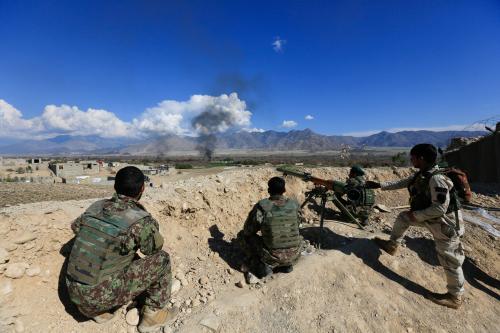
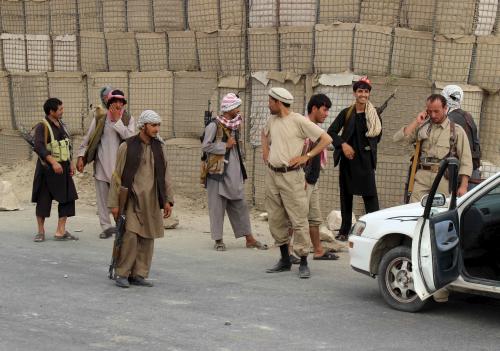
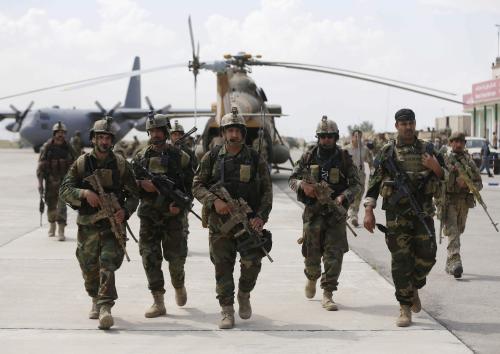
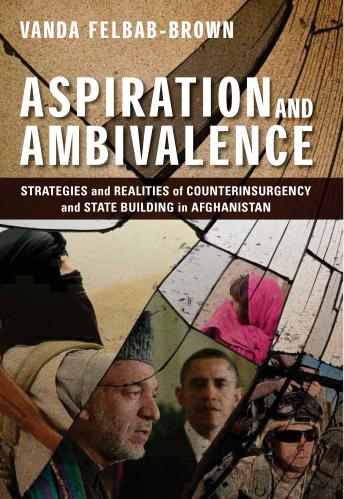

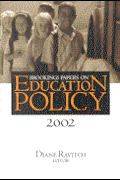

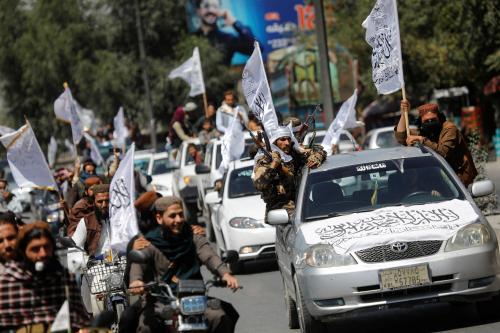
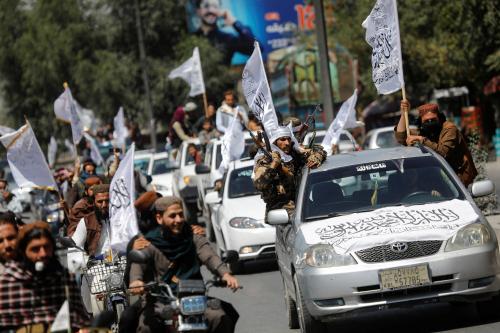
Commentary
TestimonyAfghanistan’s terrorism resurgence: Al-Qaida, ISIS, and beyond
April 27, 2017